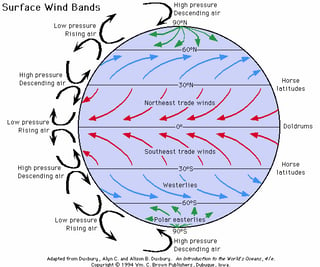Your proposed planet would essentially be a water planet, despite the small amounts of land still found on the surface. As such, we can make a few simplifying assumptions and work with some best-guess scenarios.
Air currents
Air currents are greatly simplified by this change. Rather than navigating complex topography, the surface of the Earth has been dramatically smoothed as it follows the ocean surface, which in turn follows the geoid. As such, the air currents will follow the idealized atmospheric cell circulation shown below (if this is confusing, check out my answer here for a more detailed explanation of why these patterns form):

The equator is still going to be the warmest area, as it's receiving the most solar radiation per square meter. Most of the evaporation will happen here, and the ITCZ will remain intact but will actually align nearly-perfectly with the equator, rather than being deflected to the north as it is in today's Earth.
The atmospheric cells will radiate from there, following idealized Hadley and Ferrel models. As pointed out by the Reddit link you found, the jet streams will grow a bit stronger because they no longer need to meander quite as much. You can check out what the jet stream is doing today at this cool website. They'll still run into the Himalayan Plateau and the Andes, but those will each be easier to avoid.
The winds across the planet will probably get stronger, leading to more powerful storms and more destruction when they do run into the remaining land. There's an article here that argues it won't be that large of a change, but this has been disputed by other papers.
The monsoon season would be largely minimized. Monsoons are caused by the movement of the ITCZ, which would be significantly weakened for the same reasons described above. Without a strong ITCZ, the monsoons will likely be insignificant.
Ocean currents
The oceanic currents are a bit more complex and we don't have as clear of an idea what will happen with them. Some papers find that the Earth becomes latitudinally stratified, with ice caps reaching down much further and the equator becoming warmer. Other papers find that the ocean takes over where the atmosphere fails and succeeds at transporting huge amounts of heat between the equator and the poles, leading to less a less-stratified planet that's more homogeneous temperature-wise.
The gyres themselves would largely dissipate - there's no continental mass to deflect them, so the currents would continue in their normal direction and would wrap around the planet.
Atmosphere composition
I'm not certain on this one, but it also seems likely that the increased ocean surface area will dramatically increase the amount of water in the atmosphere. Because water is a significant greenhouse gas, this will cause an increase in longwave radiation absorption and an increase in the global temperature. This could lead to a runaway greenhouse effect like L. Dutch points out in his answer.
Energy balance
Finally, the albedo of the ocean is much less than the albedo of land. This means that less incoming radiation would be reflected and more would be absorbed. Extrapolating from this site, the Earth's energy budget would increase by about 25 watts per square meter, or maybe 3% of the current amount. This would also contribute to a warmer planet and more greenhouse-like effects.


